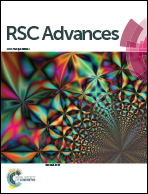A rhodamine based “turn-on” fluorescent probe for Pb(ii) and live cell imaging†
Abstract
A novel “turn-on” fluorescent chemosensor RDP-1 based on a rhodamine tri methoxy benzaldehyde conjugate was synthesized, which showed high selectivity and sensitivity towards recognition of Pb2+ in aqueous media over other metal ions and also color changes from colorless to pink, allowing colorimetric detection of Pb2+ by the naked eye. The sensitivity of probe RDP-1 towards Pb2+ was demonstrated in living cells, and can be used for selective imaging of Pb2+ in living cells.


 Please wait while we load your content...
Please wait while we load your content...